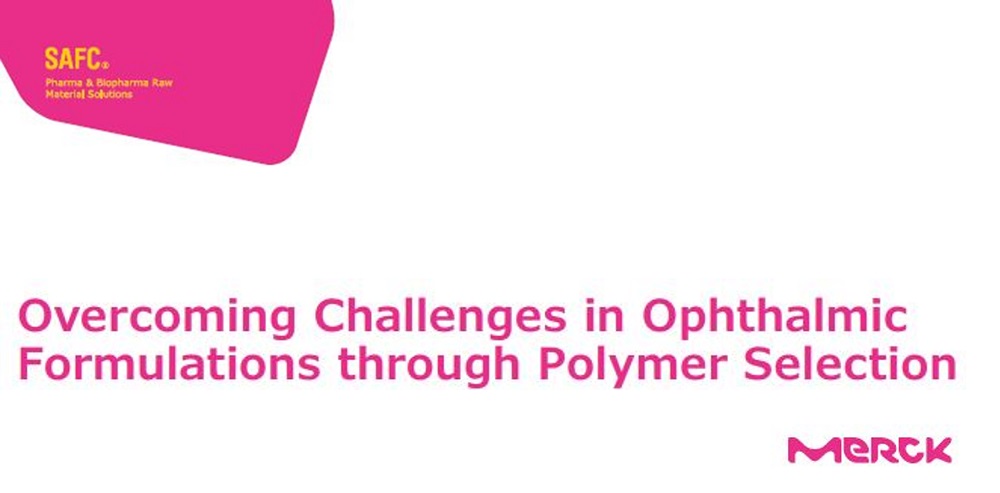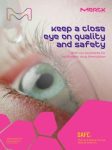Overcoming Challenges in Ophthalmic Formulations through Polymer Selection

Ophthalmic drugs are delivered to the eye to treat chronic diseases such as dry eye and acute conditions such as inflammation and infections.
The market for drugs administered to the eye is growing, in large part, due to our aging population and the increased prevalence of eye-related conditions such as diabetic retinopathy and macular degeneration. In addition, increased screen time, partially due to the pandemic, has negatively impacted eye health in both adults and pediatric populations.
Discussed in this article:
- How Can Ophthalmic Drugs be Administered
- Challenges of Ophthalmic Drug Delivery
- Benefits of Using Polymers for Ophthalmic Formulations
- Considerations for Polymer Selection for Ophthalmic Drugs
HOW CAN OPHTHALMIC DRUGS BE ADMINISTERED?
Ophthalmic drugs can be delivered to the eye via intravitreal injection, subconjuctival injection, subretinal injection and topical administration. Topical ophthalmic formulations, which are non-invasive and have minimum side effects, can take the form of solutions, emulsions, suspensions, gels, in-situ gels, ointments, and inserts.
CHALLENGES OF OPHTHALMIC DRUG DELIVERY
When compared to other administration routes, those intended for the eye present distinct delivery challenges, and the relatively low ocular bioavailability drives the need for novel approaches to improve delivery of the desired concentration, at the site of action, at a controlled rate. In addition, formulators must pay attention to several factors including:
- Tonicity
- pH
- Stability
- Viscosity
- Sterility
Ophthalmic drugs also have very specific regulatory requirements. The United States Food and Drug Administration (FDA) considers ophthalmic formulations designed for administration as eye drops to be drug–device combination products. This makes the regulatory compliance requirements much more complex than those for “standalone” drugs. Since 2008, the FDA has posted 28 product-specific bioequivalence recommendations (PSRs) for ophthalmic drug products.1 These recommendations describe bioequivalence studies (clinical, pharmacokinetic, and in vitro) that can be conducted for developing generic ophthalmic drugs and generating evidence needed to support Abbreviated New Drug Application (ANDA) approvals.
BENEFITS OF POLYMERS FOR OPHTHALMIC FORMULATIONS
Excipients play an important role in ophthalmic dosage forms, having a direct impact on critical process parameters and critical quality attributes. Polymers are an important part of the formulation toolbox and offer several benefits for ophthalmic dosage forms. They can:
- Increase contact time with the target tissue by enhancing viscosity
- Reduce drainage of the solution, helping to enhance efficacy of the drug
- Act as a solubilizer and crystallization inhibitor
- Enhance drug efficacy
- Improve formulation stability
- Provide lubricant activity
- Sustain drug release
In addition to selecting the right polymer for the formulation, aspects related to preparing the polymer solution, sterilization, and interaction with other excipients in the final formulation must be considered.
CONSIDERATIONS FOR POLYMER SELECTION FOR OPHTHALMIC FORMULATIONS
Excipients play an important role in ophthalmic dosage forms, having a direct impact on critical process parameters and critical quality attributes. Given their contribution to a successful dosage form, selection of the right polymer is a critical first step.
Types of Polymers
A variety of polymers can be used in ophthalmic formulations including those of natural, synthetic and semi-synthetic origins.
Natural polymers such as gellan, xanthan, and guar gum, and hyaluronic acid are relatively inconsistent in terms of viscosity and have the potential for a higher microbial load as compared to semi-synthetic and synthetic polymers…
Semi-synthetic polymers have a higher probability of batch-to-batch variation and broader range of viscosity compared to synthetic polymers, which can impact performance….
Polymer Compatibility with Sterilization Methods and Final Formulation
In addition to selecting the right polymer for the formulation, aspects related to preparing the polymer solution, sterilization, and interaction with other excipients in the final formulation should be considered.
Preparation of bulk-quantity polymer solutions for scale-up or commercial manufacturing can be time-consuming. For some polymers, heating is required for dissolution, and this necessitates use of jacketed vessels as well as additional time needed for heat-up of the solvent and cool-down of the polymer solution.
CONCLUSION
As the demand for drugs administered via the eye continue to increase, new excipients are needed to address their unique delivery challenges. Polymers are a class of excipients that should be considered by formulators to help overcome a wide range of obstacles for these types of medications.
Read the original and full article here
Source: Merck, www.sigmaaldrich.com
Read also the following articles about Ophthalmics and PVA by Merck:
- Overcoming Challenges in Ophthalmic Formulations through Polymer Selection – A Closer Look at Polyvinyl Alcohol
- Ophthalmics Process by Merck – Keep a close eye on quality and safety

Do you need more information or a sample of excipients by Merck?

